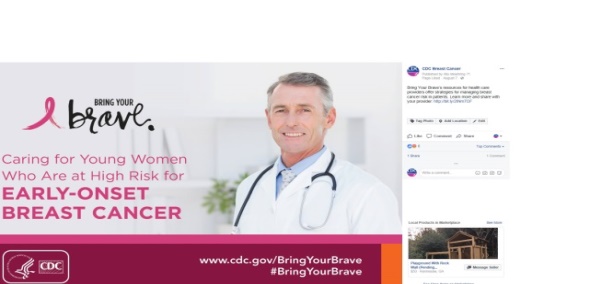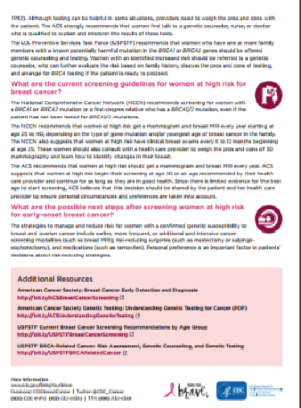0920-0572 Survey Instrument for Health Care Providers
CDC and ATSDR Health Message Testing System
Attachment_C2_Survey_for_Health_Care_Providers
"Bring Your Brave" Campaign Messages for Young Women and Health Care Providers
OMB: 0920-0572
Form Approved
OMB No. 0920-0572
Exp. Date 03/31/2018
Attachment C2:
Survey Instrument for
Health Care Providers
Public reporting burden of this collection of information is estimated to average 20 minutes per response, including the time for reviewing instructions, searching existing data sources, gathering and maintaining the data needed, and completing and reviewing the collection of information. An agency may not conduct or sponsor, and a person is not required to respond to a collection of information unless it displays a currently valid OMB control number. Send comments regarding this burden estimate or any other aspect of this collection of information, including suggestions for reducing this burden to CDC/ATSDR Information Collection Review Office, 1600 Clifton Road NE, MS D-74, Atlanta, Georgia 30333; ATTN: PRA (0920-0572).
What percentage of your patient population would you estimate is African-American/Black?
Don’t know
0%
Less than 5%
5%-24%
25-49%
50-75%
more than 75%
What percentage of your patient population would you estimate is of Ashkenazi Jewish heritage?
Don’t know
0%
Less than 5%
5%-24%
25-49%
50-75%
more than 75%
Of all your patients, approximately what percentage are covered by: (Please provide a percentage)
Medicare _________%
Medicaid _________%
Out of pocket/uninsured __________%
Privately insured __________%
Other (Specify) ______________________________ ________%
Select the three sources you find most useful in keeping up with current medical information related to well visits for women age 18-45.
Peer reviewed journals
General internet search
Social media
Mobile health apps for providers (i.e., Epocrates, UpToDate, Doximity)
Continuing Medical Education courses
Discussions with colleagues, peers
Conferences or presentations
Product theaters
National Guidelines
Medical Science Liaisons
Satellite Radio
Government health websites
Non-government health websites [please list the website names]
None of these
Other [please describe]
[For each of the top 3 sources selected in Q4] How frequently do you refer to or look at this source of information to inform your clinical practice?
Daily
At least once a week
At least once a month
Never
Other: (please describe)
Which of the following do you use to seek or share information professionally: (select all that apply)
Facebook
Twitter
Instagram
Pinterest
Blogs
Reddit
YouTube
Tumblr
Snapchat
I do not use social media professionally
Other [please specify]
Material A

Do you remember seeing
Yes
No
IF YES
Please indicate any actions you took after seeing this graphic (check all that apply)
I did not take any action after seeing this graphic
I ‘liked’ it on social media
I shared it with others on social media
I clicked on it
I looked for additional information on the topic
Other: [please describe]
IF NO
Please indicate any actions you would take after seeing this graphic (check all that apply)
I would not take any action after seeing this graphic
I would ‘liked’ it on social media
I would share it with others on social media
I would click on it
I would look for additional information on the topic
Other: [please describe]
Please indicate how much you agree or disagree with the following statements about this graphic.
|
Strongly Disagree |
Disagree |
Neutral |
Agree |
Strongly Agree |
|
1 |
2 |
3 |
4 |
5 |
|
1 |
2 |
3 |
4 |
5 |
|
1 |
2 |
3 |
4 |
5 |
|
1 |
2 |
3 |
4 |
5 |
What information would you hope to find if you clicked on this graphic?
How could this graphic be improved?
Material B


Do you remember seeing
Yes
No
IF YES
Please indicate any actions you took after seeing this factsheet (check all that apply)
I did not take any action after seeing this factsheet
I ‘liked’ it on social media
I shared it with others on social media
I thought about the issue
I talked with colleagues about this information
I clicked on a link in the factsheet
I looked for additional information on the topic
I incorporated the information into my patient visits as appropriate
Other: [please describe]
IF NO
Please indicate any actions you would take after seeing this factsheet (check all that apply)
I would not take any action after seeing this factsheet
I would ‘like’ it on social media
I would share it with others on social media
I would think about the issue
I would talk with colleagues about this information
I would click on a link in the factsheet
I would look for additional information on the topic
I would incorporate the information into my patient visits as appropriate
Other: (please explain)
What questions do you have about this factsheet or the information presented in it?
How could the factsheet be improved?
Please indicate how much you agree or disagree with the following statements about this factsheet.
ITEM |
Strongly disagree |
Somewhat disagree |
Neutral |
Somewhat Agree |
Strongly Agree |
|
|
|
|
|
|
|
|
|
|
|
|
|
|
|
|
|
|
|
|
|
|
|
|
|
|
|
|
|
|
|
|
|
|
|
|
|
|
|
|
|
|
How much of the factsheet would you read? Please choose all that apply. (D.37.d)
I would not read any of it.
I would only read the headline.
I would only read the headlines and look at the images.
I would read the whole thing.
I would read the whole thing and click on some of the links.
Where should this information be placed to most effectively reach clinicians like you?
Peer reviewed journals [please specify]
Social media [please specify]
Mobile health apps for providers (ie, Epocrates, UpToDate, Doximity)
Continuing Medical Education courses
Websites [please specify]
Email listservs [please specify]
None of these
Other [please describe]
Factsheet Section 1: Who is at high risk for early-onset breast cancer?
Is assessing your patients’ medical and family history for risk of early-onset breast cancer a topic on which you need information?
Yes
No
|
Never |
Occasionally |
Frequently |
Always |
|
|
|
|
|
|
|
|
|
|
|
|
|
|
|
Does this factsheet provide any information that would prompt or assist you in having these early-onset breast cancer risk conversations with your 18-45 year old patients?
Yes
No
How do you collect family history information:
Family Health Questionnaire or Checklist (Patient completes at home)
Family Health Questionnaire or Checklist (Patient completes in office)
Direct patient questioning (by physician, NP, or PA)
Direct patient questioning (by other office staff – e.g., RN, CMA)
Pedigree (completed by physician, NP, PA)
Other [please describe]
Select any of the following that you collect from patients regarding their personal and family medical history.
Personal history of cancer
History of chest radiation between the ages of 10-30
Cancer among first-degree relatives (parents, siblings, children)
Cancer among second-degree relatives (grandparents, aunts, uncles)
Cancer among third-degree relatives (cousins, great-grandparents
Age of cancer diagnosis among relatives
Age of death of relatives with cancer
Results of any genetic tests performed on family members
Presence of Ashkenazi Jewish heritage
The factsheet advises using an early-onset breast cancer risk assessment tool based mainly on family history. Do you regularly use any of the following?
-
Screening Tool
Ontario Family History Assessment Tool
Manchester Scoring System
Referral Screening Tool
Pedigree Assessment Tool
FHS-7
The Referral Screening Tool/B-RST
Breast Cancer Surveillance Consortium Risk Calculator
Gail Model
SHARE Workbook
Your Disease Risk
Know:BRCA
Others (please describe)
I do not regularly use an HBOC risk assessment tool
Does this factsheet provide any information you find useful regarding conducting early-onset breast cancer risk assessments?
Yes
No
Factsheet Section 2: What are the current genetic counseling and testing guidelines for women at high risk for breast cancer?
In the past 3 years, have you seen an increase in the number of 18-45 year old women |
Yes |
No |
|
|
|
|
|
|
|
|
|
|
|
|
Have you ever: |
Yes |
No |
|
|
|
|
|
|
|
|
|
Provide your opinions on advising 18-45 year old women regarding genetic testing for early-onset breast or ovarian cancer risk |
Strongly Agree |
Some-what Agree |
Some-what Disagree |
Strongly Disagree |
This isn’t something I deal with in my practice |
|
|
|
|
|
|
|
|
|
|
|
|
|
|
|
|
|
|
|
|
|
|
|
|
Before looking at this factsheet: |
||
|
Yes |
No |
|
|
|
After looking at this factsheet: |
||
|
Yes |
No |
|
|
|
Factsheet Section 3: What are the current screening guidelines for women at high risk for breast cancer?
Before looking at this factsheet: |
||
|
Yes |
No |
|
|
|
|
|
|
After looking at this factsheet: |
||
|
Yes |
No |
|
|
|
|
|
|
Factsheet Section 4: What are the possible next steps after screening women at high risk for early-onset breast cancer?
How easy or difficult do you find the following: |
Very difficult |
Somewhat difficult |
Somewhat easy |
Very easy |
I do not do this in my practice |
|
|
|
|
|
|
|
|
|
|
|
|
Would you like additional information – beyond what is in this factsheet – regarding managing a patient with a genetic mutation related to hereditary breast and ovarian cancers?
Yes
No
Additional Material Needs
Please select any of the following HBOC topics on which you need or want information.
What to do when a patient doesn’t know their family cancer medical history
Exactly what family medical history information is needed to assess risk
Scripts for communicating with patients about the evidence-base and/or guidelines you use for assessing risk and recommending appropriate screening
Scripts for communicating about how to access genetic counseling and testing
Scripts for communicating about the benefits of genetic counseling and testing for those at increased risk
Tailored and culturally relevant resources and education materials to give patients
Assistance in determining which risk assessment tool(s) to use
Assistance in determining which screening guidelines to follow for high risk patients
Assistance in determining which screening guidelines to follow for moderate risk patients
Managing breast or ovarian cancer survivors once they are in remission
Managing patients with a known BRCA or other HBOC-related genetic mutation
Other (please elaborate)
In what format do you prefer to receive information about HBOC topics (as selected in the previous question)?
CME courses
Podcasts
Infographics
Presentations
Videos
Blogs
Articles
Factsheets
Webinars
Other (please elaborate)
Where would you prefer to find that information?
Social media
Announcements or emails from my professional organizations
Conferences or meetings
Professional organization websites
Government websites
Research literature
Professional publications/journals
Internal communication channels within my healthcare organization
Other
| File Type | application/vnd.openxmlformats-officedocument.wordprocessingml.document |
| Author | Wilburn, Ben |
| File Modified | 0000-00-00 |
| File Created | 2021-01-21 |
© 2025 OMB.report | Privacy Policy